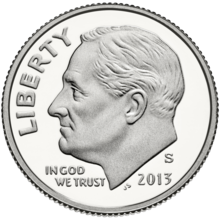Roosevelt Dime
| United States | |
| Value | 10 cents (.10 US dollars) |
|---|---|
| Mass | Silver 2.500 g. Clad: 2.268 g |
| Diameter | 17.91 mm (0.705 in) |
| Edge | 118 reeds |
| Composition |
|
| Silver | 0.07234 troy oz |
| Years of minting | 1946 to present |
| Mint marks | P, D, S, W. Located from 1946 to 1964 on the lower reverse to the left of the torch, since 1968 on the obverse above the date. No mint mark used at Philadelphia before 1980 or at any mint from 1965 to 1967. |
| Obverse | |
 |
|
| Design | Franklin D. Roosevelt |
| Designer | John R. Sinnock |
| Design date | 1946 |
| Reverse | |
 |
|
| Design | Torch with branches of oak and olive |
| Designer | John R. Sinnock |
| Design date | 1946 |
The Roosevelt dime is the current dime, or ten-cent piece, of the United States. Struck by the United States Mint continuously since 1946, it depicts President Franklin D. Roosevelt on the obverse and was authorized soon after his 1945 death.
Roosevelt had been stricken with polio, and was one of the moving forces of the March of Dimes. The ten-cent coin could be changed by the Mint without the need for congressional action, and officials moved quickly to replace the Mercury dime. Chief Engraver John R. Sinnock prepared models, but faced repeated criticism from the Commission of Fine Arts. Sinnock modified his design in response, and the coin went into circulation in January 1946.
The Roosevelt dime has been struck continuously since then in large numbers, and ordinary issues are not rare. The Mint transitioned from striking the coin in silver to base metal in 1965, and the design basically remains unaltered from when Sinnock created it. Without rare dates, the dime is less widely collected than other modern American coins.
President Franklin D. Roosevelt died on April 12, 1945, after leading the United States through much of the Depression and World War II. Roosevelt had suffered from polio and had helped found and strongly supported the March of Dimes to fight that crippling disease, thus the ten-cent piece was an obvious way of honoring a president popular for his war leadership. On May 3, Louisiana Representative James Hobson Morrison introduced a bill for a Roosevelt dime. On May 17, Treasury Secretary Henry Morgenthau Jr. announced that the Mercury dime (also known as the Winged Liberty dime) would be replaced by a new coin depicting Roosevelt, to go into circulation about the end of the year. About 90 percent of the letters received by Stuart Mosher, editor of The Numismatist (the journal of the American Numismatic Association) were supportive of the change, but he was not, pointing out that the Mercury design was beautiful and that the limited space on the dime would not do justice to Roosevelt, advocating a commemorative silver dollar instead. Others objected that despite his merits, Roosevelt had not earned a place alongside Lincoln, Washington and Jefferson, the only presidents honored on the circulating coinage to that point. Under the law, as the Mercury design, first coined in 1916, had been struck for at least 25 years, it could be changed by the Bureau of the Mint, and no congressional action was required, though the committees of each house with jurisdiction over the coinage were informed.
...
Wikipedia
